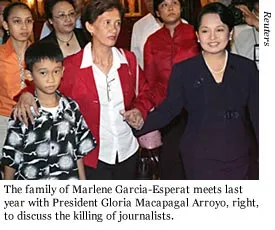New York, March 23, 2006—One year after Philippine columnist Marlene Garcia-Esperat was gunned down in her home in Tacurong, lawyers for her family are expected to ask a judge to reinstate murder charges against two regional agriculture officials suspected of ordering the killing. The Committee to Protect Journalists urges the court to give utmost consideration to the request and to ensure that all those responsible for the murder are charged and brought to justice.
Garcia-Esperat, 45, was shot in the head on March 24, 2005, as her two children watched. Her weekly anti-graft column, “Madame Witness,” appeared in the Midland Review in the southern island of Mindanao. She had recently written an article about the misuse of government funds allocated to buy fertilizer.
Four suspects, charged last April with carrying out the crime, are awaiting trial in Cebu. One of them, Randy Barua, told police that two officials from the Mindanao Department of Agricuture, Osmeña Montañer and Estrella Sabay, had asked him to hire gunmen to kill the journalist.
Subsequent murder charges against Montañer and Sabay were dropped on August 31. The decision to drop the charges, which was not made public until September 20, was assailed by the victim’s family and press freedom groups.
On Friday, the anniversary of the journalist’s murder, a judge in Cebu is expected to consider a motion filed by Garcia-Esperat’s lawyers to reinstate charges against Montañer and Sabay. Montaner and his family recently left the country on a trip to the Middle East, a lawyer for Garcia-Esperat’s family told the Philippine Daily Inquirer earlier this month.
“Justice will not be served until everyone responsible for this cold-blooded assassination is prosecuted,” said Ann Cooper, CPJ’s executive director. “This is an important moment for the Philippine justice system to say clearly that the powerful and influential people who would order the killing of a journalist are not above the law.”
A chemist by training, Garcia-Esperat began her work exposing corruption in the early 1990s. During her tenure as ombudsman for the Department of Agriculture, she filed legal actions against several officials accusing them of graft, according to the Inquirer.
Garcia-Esperat became a full-time journalist in 2004 after growing frustrated with the government’s tepid reaction to corruption, she told the Inquirer. She also hosted a program on local radio station DXKR.
At the time of her killing, Garcia-Esperat was under police protection because of a series of death threats. Local news reports said that on the day of the shooting she let her two guards leave early for the Easter holiday.
The Philippines is one of the most dangerous places in the world for journalists, CPJ research shows. Four Philippine journalists, including Garcia-Esperat, were murdered in 2005 in retaliation for their work.
